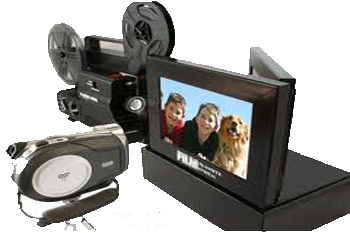
Film Conversion Equipment
Film Scanning and Film Transfer Equipment Types
The type of film scanning machine used for your 8mm, Super 8 or 16mm film conversion will have as much of an impact on the quality you receive as the resolution of the scan itself will. For example, if you wanted to digitize a photograph and tried doing it two different ways. You first put the photograph down on a table and took a picture of it using your smart phone or camera. Then you took the picture and scanned it using a flatbed scanner. If you compare the two side by side on your computer it will become really obvious that the flatbed scanner produced a digital image as good as the photograph. However, the picture you took with your phone or camera does not look close to the quality of the original photograph.
The same goes for scanning your 8mm, Super 8 or 16mm film. The real-time and frame by frame machines below are using a camcorder to take a picture of your film. The motion picture film scanner and Datacine machine are scanning the film. The results will be significantly different.
Film Conversion Equipment |
|
Real Time
|
|
Frame by Frame
|
|
Professional Film Scanners
|
|
So, at this point you’ve learned that film transfers can capture at standard definition (480 lines), high definition (1080 lines) or 2K (1556 lines). You’ve also learned about the 3 different types of film transfers being used today. In order from least to best quality we have:
Tulsa Fun Facts: Tulsa is located in northeastern Oklahoma on the Arkansas River. With a population of around 390,000, it is the second-largest city in the state. Settled in the 1830s by Creek Indians, Tulsa attracted white settlers and became a cattle-shipping center with the arrival of railroads in 1882. An oil boom at the turn of the century brought dramatic growth.
Oklahoma Fun Facts: The land that today makes up Oklahoma was added to the United States as part of the Louisiana Purchase of 1803. Throughout the 19th century, the U.S. governmentrelocated Indian tribes from the southeastern United Statesto the area, and by 1900, over 30 Indian tribes had beenmoved to what was originally calledthe Indian Territories. At the same time, ranchers in Texas began to move into the area in search of new pasture lands, and the government eventually opened the land to settlement, creating “land runs” in which settlers were allowed to cross the border at a particular hour to claim homesteads.








